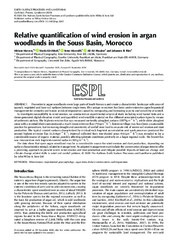Relative quantification of wind erosion in argan woodlands in the Souss Basin, Morocco
DOI: https://doi.org/10.1002/esp.5002
Persistent URL: http://resolver.sub.uni-goettingen.de/purl?gldocs-11858/9247
Persistent URL: http://resolver.sub.uni-goettingen.de/purl?gldocs-11858/9247
Marzen, Miriam; Kirchhoff, Mario; Marzolff, Irene; Aït Hssaine, Ali; Ries, Johannes B., 2020: Relative quantification of wind erosion in argan woodlands in the Souss Basin, Morocco. In: Earth Surface Processes and Landforms, DOI: 10.1002/esp.5002.
 |
Dokument öffnen: |
The endemic argan woodlands cover large parts of South Morocco and create a characteristic landscape with areas of sparsely vegetated and bare soil surfaces between single trees. This unique ecosystem has been under extensive agrosilvopastoral management for centuries and is now at risk of degradation caused by overgrazing and increasing scarcity and variability of rainfall.
To investigate susceptibility to wind erosion, we conducted an experimental–empirical study including wind tunnel tests and a drone-generated digital elevation model and quantified wind-erodible material on five different associated surface types by means of sediment catchers. The highest emission flux was measured on freshly ploughed surfaces (1875 g m–2 h–1), while older ploughed areas with a re-established crust produced a much lower emission flux (795 g m–2 h–1). Extensive tillage may have been a sustainable practice for generations, but increasing drought and uncertainty of rainfall now lead to an acute risk of severe soil erosion and dust production. The typical crusted surfaces characterized by residual rock fragment accumulation and wash processes produced the second highest emission flux (1,354 g m–2 h–1). Material collected from tree-shaded areas (933 g m–2 h–1) was revealed to be a considerable source of organic material, possibly affecting substrate conditions positively on a larger regional scale. The lowest flux was measured on rock fragment-covered surfaces (301 g m–2 h–1).
The data show that open argan woodland may be a considerable source for wind erosion and dust production, depending on surface characteristics strongly related to management. An adapted management must include the conservation of argan trees to offer a promising approach to prevent severe wind erosion and dust production and mitigate possible impacts of land-use change and climate change related shifts in wind and rainfall patterns. © 2020 The Authors. Earth Surface Processes and Landforms published by John Wiley & Sons Ltd
Statistik:
ZugriffsstatistikSammlung:
- Geologie [933]
Schlagworte:
Wind erosionexperimental geomorphology
argan trees
dryland environments
soil degradation
This is an open access article under the terms of the Creative Commons Attribution License, which permits use, distribution and reproduction in any medium, provided the original work is properly cited.

